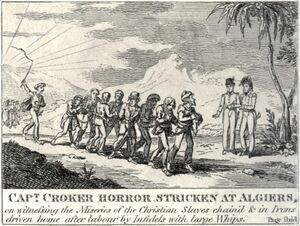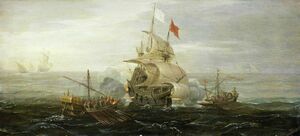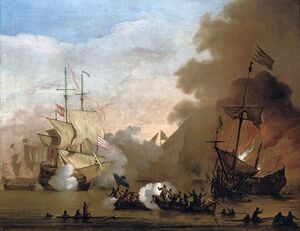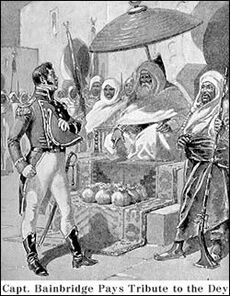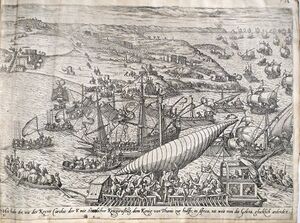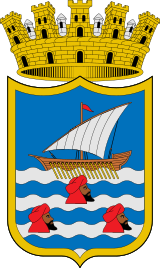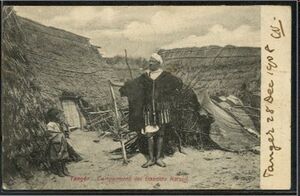قراصنة الساحل البربري


قرصنة البربر، أو قرصنة العثمانيين أو قرصنة البربر أو الجهاد البحري الإسلامي، هي العمليات التي قام بها المسلمون ضد سواحل أو سفن الدول الاوروپية المعادية لها من القرن السادس عشر إلى أوائل القرن التاسع عشر في منطقة الغربية للبحر الأبيض المتوسط وعلى طول سواحل المحيط الأطلسي الاوروپية والأفريقية. كانت قواعد انطلاقهم كانت معاقل منتشرة على طول سواحل شمال أفريقيا (خصوصاً مدن تونس و طرابلس والجزائر وسلا وموائي أخرى بالمغرب).
بالنظر لما تعرض له المسلمون في الاندلس، والهجمات الأوروبية على الشمال الأفريقي باحتلال الپرتغال لمدينة سبتة عام 1415، واستيلاء الأسپان على المرسى الكبير عام 1505 ومدن حجر باديس ووهران وبجاية سنة 1508 وطرابلس الغرب في عام 1535 قبل أن يتنازلوا عنها لفرسان القديس يوحنا.
فإنه من الظلم اعتبار تلك الهجمات من "أعمال القرصنة" كما أطلق عليها الأوروبيون، بل كانت أعمال قتالية ضد دول هي أصلاً في حالة حرب معها. وقد انتقلت هذه إلى التسمية (القرصنة) إلى بعض الكتب العربية دونما تمييز.
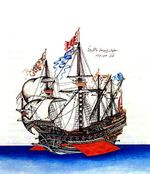
وقد كانت قرصنة البربر وتجارة العبيد واختطاف الاوروبيين واستعبادهم، هي السبب المعلن لما تعرضت له مدن الجزائر ووهران وطنجة والمرسى الكبير وقرطاج وطرابلس والدار البيضاء، في الفترة من 1750-1830 من قصف مدفعي مكثف، نحو 5-10 مرات لكل مدينة، من أساطيل بريطانيا وهولندا واسبانيا والدنمارك والسويد والولايات المتحدة وإيطاليا وفرنسا.
التاريخ
Barbary pirates were active from medieval times to the 1800s.
The Middle Ages
In 1198 the problem of Barbary piracy and slave-taking was so great that the Trinitarians, a religious order, were founded to collect ransoms and even to exchange themselves as ransom for those captured and pressed into slavery in North Africa. In the 14th century Tunisian corsairs became enough of a threat to provoke a Franco-Genoese attack on Mahdia in 1390, also known as the "Barbary Crusade". Morisco exiles of the Reconquista and Maghreb pirates added to the numbers, but it was not until the expansion of the Ottoman Empire and the arrival of the privateer and admiral Kemal Reis in 1487 that the Barbary corsairs became a true menace to shipping from European Christian nations.[1]
القرن السادس عشر

From 1559, these African cities, although nominally part of the Ottoman Empire, were in fact military republics that chose their own rulers and lived by war booty captured from the Spanish and Portuguese. There are several cases of Sephardic Jews, including Sinan Reis and Samuel Pallache, who upon fleeing Iberia turned to attacking the Spanish Empire's shipping under the Ottoman flag, a profitable strategy of revenge for the Inquisition's religious persecution.[2][3]
During the first period (1518–1587), the beylerbeys were admirals of the sultan, commanding great fleets and conducting war operations for political ends. They were slave-hunters and their methods were ferocious. After 1587, the sole object of their successors became plunder, on land and sea. The maritime operations were conducted by the captains, or reises, who formed a class or even a corporation. Cruisers were fitted out by investors and commanded by the reises. Ten percent of the value of the prizes was paid to the pasha or his successors, who bore the titles of agha or dey or bey.[4]
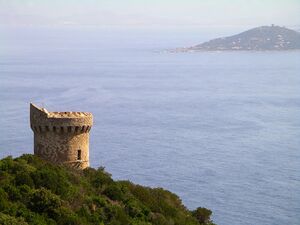
In 1544 Hayreddin captured the island of Ischia, taking 4,000 prisoners, and enslaved some 2,000–7,000 inhabitants of Lipari.[5][6] In 1551 Turgut Reis enslaved the entire population of the Maltese island of Gozo, between 5,000 and 6,000, sending them to Ottoman Tripolitania. In 1554 corsairs under Turgut Reis sacked Vieste, beheaded 5,000 of its inhabitants, and abducted another 6,000.[7]
القرن 17
A notable counter action occurred in 1607, when the Knights of Saint Stephen (under Jacopo Inghirami) sacked Bona in Algeria, killing 470 and taking 1,464 captives.[8] This victory is commemorated by a series of frescoes painted by Bernardino Poccetti in the "Sala di Bona" of Palazzo Pitti, Florence.[9][10] In 1611 Spanish galleys from Naples, accompanied by the galleys of the Knights of Malta, raided the Kerkennah Islands off the coast of Tunisia and took away almost 500 Muslim captives.[11] Between 1568 and 1634 the Knights of Saint Stephen may have captured about 14,000 Muslims, with perhaps one-third taken in land raids and two-thirds taken on captured ships.[11]

Ireland was subject to a similar attack. In June 1631 Murat Reis, with corsairs from Algiers and armed troops of the Ottoman Empire, stormed ashore at the little harbor village of Baltimore, County Cork. They captured almost all the villagers and took them away to a life of slavery in North Africa.[4] The prisoners were destined for a variety of fates – some lived out their days chained to the oars as galley slaves, while women spent long years as concubines in harems or within the walls of the sultan's palace. Only two of these captives ever returned to Ireland.[12][صفحة مطلوبة] England was also subject to pirate raids, in 1640 sixty men, women and children were enslaved by Algerian pirates who raided Penzance.[13][14]
More than 20,000 captives were said to be imprisoned in Algiers alone. The rich were often able to secure release through ransom, but the poor were condemned to slavery. Their masters would on occasion allow them to secure freedom by professing Islam. A long list might be given of people of good social position, not only Italians or Spaniards, but German or English travelers in the south, who were captives for a time.[4]

In 1675 a Royal Navy squadron led by Sir John Narborough negotiated a lasting peace with Tunis and, after bombarding the city to induce compliance, with Tripoli.[15]
القرن 18 و19
Piracy was enough of a problem that some states entered into the redemption business. In Denmark, "At the beginning of the 18th century money was collected systematically in all churches, and a so called 'slave fund' (slavekasse) was established by the state in 1715. Funds were brought in through a compulsory insurance sum for seafarers. 165 slaves were ransomed by this institution between 1716 and 1736."[16] "Between 1716 and 1754 19 ships from Denmark-Norway were captured with 208 men; piracy was thus a serious problem for the Danish merchant fleet."[16]
During the American Revolution the pirates attacked American merchant vessels in the Mediterranean. But, on December 20, 1777, Sultan Mohammed III of Morocco issued a declaration recognizing America as an independent country, and stating that American merchant ships could enjoy safe passage into the Mediterranean and along the coast.[17] The relations were formalized with the Moroccan-American Treaty of Friendship signed in 1786, which stands as the U.S.'s oldest non-broken friendship treaty[18][19] with a foreign power.
Until the American Declaration of Independence in 1776, British treaties with the North African states protected American ships from the Barbary corsairs. Morocco, which in 1777 was the first independent nation to publicly recognize the United States, in 1784 became the first Barbary power to seize an American vessel after the nation achieved independence[بحاجة لمصدر]. The Barbary threat led directly to the United States founding the United States Navy in March 1794. While the United States did secure peace treaties with the Barbary states, it was obliged to pay tribute for protection from attack. The burden was substantial: from 1795, the annual tribute paid to the Regency of Algiers amounted to 20% of United States federal government's annual expenditures.[20]
In 1798, an islet near Sardinia was attacked by the Tunisians, and more than 900 inhabitants were taken away as slaves.[21]

أغسطس 1816، توماس لوني.]]
The Barbary states had difficulty securing uniform compliance with a total prohibition of slave-raiding, as this had been traditionally of central importance to the North African economy. Slavers continued to take captives by preying on less well-protected peoples. Algiers subsequently renewed its slave-raiding, though on a smaller scale. Europeans at the Congress of Aix-la-Chapelle in 1818 discussed possible retaliation. In 1824 a British fleet under Admiral Sir Harry Neal bombarded Algiers. Corsair activity based in Algiers did not entirely cease until France conquered the state in 1830.[4]
عبيد البربر

From bases on the Barbary coast, North Africa, the Barbary pirates raided ships traveling through the Mediterranean and along the northern and western coasts of Africa, plundering their cargo and enslaving the people they captured. From at least 1500, the pirates also conducted raids along seaside towns of Italy, France, Spain, Portugal, England, the Netherlands and as far away as Iceland, capturing men, women and children. On some occasions, settlements such as Baltimore, Ireland were abandoned following the raid, only being resettled many years later. Between 1609 and 1616, England alone had 466 merchant ships lost to Barbary pirates.[22]
Slave quarters
At night the slaves were put into prisons called 'bagnios' (derived from the Italian word "bagno" for public bath, inspired by the Turks' use of Roman baths at Constantinople as prisons),[23] which were often hot and overcrowded. Bagnios had chapels, hospitals, shops, and bars run by captives.[24]
رقيق الغلايين
Although the conditions in bagnios were harsh, they were better than those endured by galley slaves. Most Barbary galleys were at sea for around eighty to a hundred days a year, but when the slaves assigned to them were on land, they were forced to do hard manual labor. There were exceptions: "galley slaves of the Ottoman Sultan in Constantinople would be permanently confined to their galleys, and often served extremely long terms, averaging around nineteen years in the late seventeenth-century and early eighteenth-century periods. These slaves rarely got off the galley but lived there for years."[25] During this time, rowers were shackled and chained where they sat, and never allowed to leave. Sleeping (which was limited), eating, defecation and urination took place at the seat to which they were shackled. There were usually five or six rowers on each oar. Overseers would walk back and forth and whip slaves considered not to be working hard enough.
Number of people enslaved
According to Robert Davis, between 1 million and 1.25 million Europeans were captured by Barbary pirates and sold as slaves in North Africa and Ottoman Empire between the 16th and 19th centuries.[26][27] However, to extrapolate his numbers, Davis assumes the number of European slaves captured by Barbary pirates were constant for a 250-year period, stating:
There are no records of how many men, women and children were enslaved, but it is possible to calculate roughly the number of fresh captives that would have been needed to keep populations steady and replace those slaves who died, escaped, were ransomed, or converted to Islam. On this basis it is thought that around 8,500 new slaves were needed annually to replenish numbers – about 850,000 captives over the century from 1580 to 1680. By extension, for the 250 years between 1530 and 1780, the figure could easily have been as high as 1,250,000.[28]
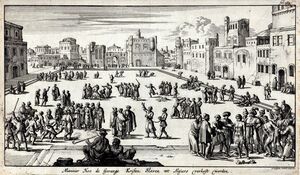
Davis' numbers have been questioned by the historian David Earle, who said of Davis' numbers "His figures sound a bit dodgy and I think he may be exaggerating" and cautioned that the true picture of European slaves is clouded by the fact that the corsairs also seized non-Christian whites from eastern Europe and black people from west Africa.[28]
In addition, the number of slaves traded was hyperactive, with exaggerated estimates relying on peak years to calculate averages for entire centuries, or millennia. Hence, there were wide fluctuations year-to-year, particularly in the 18th and 19th centuries, given slave imports, and given the fact that, prior to the 1840s, there are no consistent records. Middle East expert, John Wright, cautions that modern estimates are based on back-calculations from human observation.[29]
Such observations, across the late 1500s and early 1600s observers, account for around 35,000 European Christian slaves held throughout this period on the Barbary Coast, across Tripoli, Tunis, but mostly in Algiers. The majority were sailors (particularly those who were English), taken with their ships, but others were fishermen and poor coastal villagers. However, most of these captives were people from lands close to Africa, particularly Spain and Italy.[30]
، 13 يونيو 1830.]]
قراصنة الساحل البربري
According to historian Adrian Tinniswood, the most notorious corsairs were European renegades who had learned their trade as privateers, and who moved to the Barbary Coast during peacetime to pursue their trade. These outcasts, who had converted to Islam, brought up-to-date naval expertise to the piracy business, and enabled the corsairs to make long-distance slave-catching raids as far away as Iceland and Newfoundland.[31] Infamous corsair Henry Mainwaring, who was initially a lawyer and pirate-hunter, later returned home to a royal pardon. Mainwaring later wrote a book about the practise of piracy in the Mediterranean, aptly titled the Discourse of Pirates. In the book, Mainwaring outlined potential methods to hunt down and eliminate piracy.[31]
الأخوان برباروس
 مقالات مفصلة: خير الدين برباروس
مقالات مفصلة: خير الدين برباروس- عروج برباروس
Oruç Barbarossa
The most famous of the corsairs in North Africa were the Barbarossa brothers, Aruj and Khayr al-Din. They, and two less well-known brothers all became Barbary corsairs in the service of the Ottoman Empire; they were called the Barbarossas (Italian for Redbeards) after the red beard of Oruç, the eldest. Oruç captured the island of Djerba for the Ottoman Empire in 1502 or 1503. He often attacked Spanish territories on the coast of North Africa; during one failed attempt in 1512 he lost his left arm to a cannonball. The eldest Barbarossa also went on a rampage through Algiers in 1516, and captured the town with the help of the Ottoman Empire. He executed the ruler of Algiers and everybody he suspected would oppose him, including local rulers. He was finally captured and killed by the Spanish in 1518, and put on display.
Hızır Hayreddin Barbarossa

Oruç, based mainly on land, was not the best-known of the Barbarossas. His youngest brother Hızır (later called Hayreddin or Kheir ed-Din) was a more traditional corsair. He was a capable engineer and spoke at least six languages. He dyed the hair of his head and beard with henna to redden it like Oruç's. After capturing many crucial coastal areas, Hayreddin was appointed admiral-in-chief of the Ottoman sultan's fleet. Under his command the Ottoman Empire was able to gain and keep control of the Mediterranean for over thirty years. Barbaros Hızır Hayreddin Pasha died in 1546 of a fever, possibly the plague.
الكابتن جاك وارد
English corsair Jack, or John, Ward was once called "beyond doubt the greatest scoundrel that ever sailed from England" by the English ambassador to Venice. Ward was a privateer for Queen Elizabeth during her war with Spain; after the end of the war, he became a corsair. With some associates he captured a ship in about 1603 and sailed it to Tunis; he and his crew converted to Islam. He was successful and became rich. He introduced heavily armed square-rigged ships, used instead of galleys, to the North African area, a major reason for the Barbary's future dominance of the Mediterranean. He died of plague in 1622.
Sayyida al-Hurra
Sayyida al-Hurra was a female Muslim cleric, merchant, governor of Tétouan, and later the wife of the sultan of Morocco.[32][33] She was born around 1485 in the Emirate of Granada, but was forced to flee to Morocco when she was very young to escape the Reconquista. In Morocco, she gathered a crew largely of exiled Moors, and launched pirate expeditions against Spain and Portugal to avenge the Reconquista, protect Morocco from Christian pirates, and seek riches and glory. She co-founded the Barbary Corsairs with her allies the Barbarossa brothers. Sayyida al-Hurra became wealthy and renowned enough for the Sultan of Morocco, Ahmad al-Wattasi to make her his queen. Notably, however, she refused to marry in his capital of Fez, and would not get married but in Tétouan, of which she was governor. This was the first and only time in history that a Moroccan monarch had married away from his capital.
Other Barbary corsairs
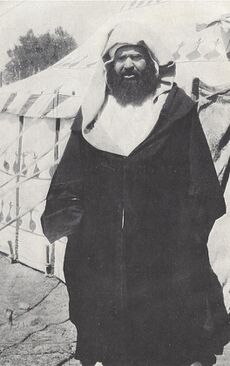
- Kemal Reis (ح. 1451–1511)
- Gedik Ahmed Pasha (died 1482)
- Sinan Reis (died 1546)
- Piri Reis (died 1554 or 1555)
- Turgut Reis (1485–1565)
- Sinan Pasha (died 1553)
- Kurtoğlu Muslihiddin Reis (1487–ح. 1535)
- Kurtoğlu Hızır Reis
- Salih Reis (ح. 1488–1568)
- Seydi Ali Reis (1498–1563)
- Piyale Pasha (ح. 1515–1578)
- Raïs Hamidou (1773–1815)
- Uluç Ali Reis (1519–1587)
- Ali Bitchin (ح. 1560–1645)
- Simon de Danser or Simon Reis (ح. 1579–ح. 1611)
- Ivan-Dirkie de Veenboer or Sulayman Reis (died 1620)
- Murat Reis the Elder (ح. 1534–1638)
- Jan Janszoon or Murat Reis the Younger (ح. 1570–after 1641)
في الأدب
Barbary corsairs are protagonists in Le pantere di Algeri (the panthers of Algiers) by Emilio Salgari. They were featured in a number of other noted novels, including Robinson Crusoe by Daniel Defoe, The Count of Monte Cristo by Alexandre Dumas, père, The Wind in the Willows by Kenneth Grahame, The Sea Hawk and the Sword of Islam by Rafael Sabatini, The Algerine Captive by Royall Tyler, Master and Commander by Patrick O'Brian, the Baroque Cycle by Neal Stephenson, The Walking Drum by Louis Lamour, Doctor Dolittle by Hugh Lofting, Corsair by Clive Cussler and Angélique in Barbary by Anne Golon. Miguel de Cervantes, the Spanish author, was captive for five years as a slave in the bagnio of Algiers, and reflected his experience in some of his fictional (but not directly autobiographical) writings, including the Captive's tale in Don Quixote, his two plays set in Algiers, El Trato de Argel (The Treaty of Algiers) and Los Baños de Argel (The Baths of Algiers), and episodes in a number of other works. In Mozart's opera Die Entführung aus dem Serail (a Singspiel), two European ladies are discovered in a Turkish harem, presumably captured by Barbary corsairs. Rossini's opera L'Italiana in Algeri is based on the capture of several slaves by Barbary corsairs led by the bey of Algiers.
One of the stereotypical features of a pirate as portrayed in popular culture, the eye patch, may have been partially derived from the Arab corsair Rahmah ibn Jabir al-Jalahimah, who wore a patch after losing an eye in battle in the 18th century.[34]
انظر أيضاً
- Albanian piracy
- Anglo-Turkish piracy
- تجارة العبيد في الساحل البربري
- الرق في الدولة العثمانية
- Turkish Abductions
- معاهدات الساحل البربري
- Circassian beauties
- غزوات
- البحرية العثمانية
- الإسلام والرق
- قائمة الحصارات والإنزالات العثمانية
- Ottoman–Habsburg wars
- غزوة بالتمور
- بياله باشا
- Romegas
- كمال رايس
- سيدي علي رايس
- صالح رايس
- Kurtoğlu Muslihiddin Reis
- Kurtoğlu Hızır Reis
- Gedik Ahmed Pasha
- Uluç Ali Reis
- مراد رايس الكبير
- Tybalt Rosembraise
- Republic of Bou Regreg
- Turgut Reis
- مورسكيون
- دستور الولايات المتحدة، Articles Congress could not pay.
- Slavery in the Ottoman Empire
- Turkish Abductions
هوامش
- ^ Pryor (1988), p. 192
- ^ Kritzler, Edward (November 3, 2009). Jewish Pirates of the Caribbean. Anchor. pp. 59–60. ISBN 978-0-7679-1952-4. Retrieved 2010-05-02.
- ^ Plaut, Steven (October 15, 2008). "Putting the Oy Back into 'Ahoy'". Retrieved 2010-04-27. [1][2][3] Archived 2013-11-10 at the Wayback Machine
- ^ أ ب ت ث
 Chisholm, Hugh, ed. (1911). . دائرة المعارف البريطانية (eleventh ed.). Cambridge University Press.
Chisholm, Hugh, ed. (1911). . دائرة المعارف البريطانية (eleventh ed.). Cambridge University Press. {{cite encyclopedia}}: Cite has empty unknown parameter:|coauthors=(help) - ^ Syed, Muzaffar Husain; Akhtar, Syed Saud; Usmani, B. D. (2011-09-14). Concise History of Islam (in الإنجليزية). Vij Books India Pvt Ltd. ISBN 9789382573470.
- ^ Her Majesty's Commission, State Papers (1849). King Henry the Eighth Volume 10 Part V Foreign Correspondence 1544-45. London.
- ^ Mercati, Angelo (1982). Saggi di storia e letteratura, vol. II. Rome.
{{cite book}}: CS1 maint: location missing publisher (link) - ^ John B. Hattendorf and Richard W. Unger (2003). War at Sea in the Middle Ages and the Renaissance. Boydell Press.
{{cite book}}: CS1 maint: location missing publisher (link) - ^ "Curator's comments on a draft study by Bernardino Poccetti". The British Museum.
- ^ "Palazzo Pitti".
- ^ أ ب Jamieson, Alan (2012). Lords of the Sea: A History of the Barbary Corsairs. London.
{{cite book}}: CS1 maint: location missing publisher (link) - ^ Ekin, Des (2006). The Stolen Village – Baltimore and the Barbary Pirates. OBrien. ISBN 978-0-86278-955-8.
- ^ British Captives from the Mediterranean to the Atlantic, 1563-1760. Nabil Matar.
- ^ Pirates of Barbary. Adrian Tinniswood. Random House.
- ^ Articles of peace & commerce between ... Charles II ... and the ... Lords the Bashaw, Dey, Aga, Divan, and governours of the ... kingdom of Tripoli concluded by Sir John Narbrough ... the first day of May, 1676. University of Michigan.
- ^ أ ب Peter Madsen, "Danish slaves in Barbary", Islam in European Literature Conference, Denmark Archived نوفمبر 10, 2014 at the Wayback Machine
- ^ Tucker, Spencer C. (2014-06-11). The Encyclopedia of the Wars of the Early American Republic, 1783–1812: A Political, Social, and Military History [3 volumes]: A Political, Social, and Military History. ISBN 9781598841572.
- ^ Roberts, Priscilla H. and Richard S. Roberts, Thomas Barclay (1728–1793: Consul in France, Diplomat in Barbary, Lehigh University Press, 2008, pp. 206–223.
- ^ "Milestones of American Diplomacy, Interesting Historical Notes, and Department of State History". U.S. Department of State. Retrieved 2007-12-17.
- ^ David Brion Davis, Steven Mintz (2000). The Boisterous Sea of Liberty A Documentary History of America from Discovery through the Civil War. Oxford University Press. p. 222. ISBN 978-0-19-511669-4.
- ^ Christian Slaves, Muslim Masters: White Slavery in the Mediterranean, the Barbary Coast and Italy, 1500–1800. Robert Davis (2004). p.45. ISBN 1-4039-4551-9.
- ^ Rees Davies, "British Slaves on the Barbary Coast", BBC, 1 July 2003
- ^ Definition of "bagnio" from the Free Merriam-Webster Dictionary. Accessed 23 February 2015
- ^ H. G. Barnby (1966). The Prisoners of Algiers: An Account of the Forgotten American-Algerian War 1785-1797. Oxford U.P. p. 45-52.
- ^ Ekin, Des (2006). The Stolen Village – Baltimore and the Barbary Pirates. OBrien. p. 187. ISBN 978-0-86278-955-8.
- ^ Davis, Robert. Christian Slaves, Muslim Masters: White Slavery in the Mediterranean, the Barbary Coast and Italy, 1500–1800.[4]
- ^ "When Europeans were slaves: Research suggests white slavery was much more common than previously believed" Archived 2011-07-25 at the Wayback Machine, Research News, Ohio State University
- ^ أ ب Carroll, Rory; correspondent, Africa (2004-03-11). "New book reopens old arguments about slave raids on Europe". The Guardian (in الإنجليزية البريطانية). ISSN 0261-3077. Retrieved 2017-12-11.
- ^ Wright, John (2007). "Trans-Saharan Slave Trade". Routledge.
- ^ Davis, Robert (17 Feb 2011). "British Slaves on the Barbary Coast". BBC.
- ^ أ ب خطأ استشهاد: وسم
<ref>غير صحيح؛ لا نص تم توفيره للمراجع المسماةToll - ^ Mernissi, Fatima (July 30, 1997). The Forgotten Queens of Islam. Univ of Minnesota Press. pp. 18–19, 115, 193. ISBN 978-0-8166-2439-3.
- ^ Park, Thomas Kerlin; Boum, Aomar (2006). Historical dictionary of Morocco. The Scarecrow Press, Inc. p. 317. ISBN 978-0-8108-5341-6.
- ^ Charles Belgrave (1966), The Pirate Coast, p. 122, George Bell & Sons
المصادر
- Clissold, Stephen. 1976. "CHRISTIAN RENEGADES AND BARBARY CORSAIRS." History Today 26, no. 8: 508-515. Historical Abstracts.
- Davis, Robert C., Christian Slaves, Muslim Masters: White Slavery in the Mediterranean, The Barbary Coast, and Italy, 1500-1800. Palgrave Macmillan, New York. 2003. ISBN 0-333-71966-2
- Earle, Peter. The Pirate Wars. Thomas Dunne. 2003
- Forester, C. S. The Barbary Pirates. Random House. 1953
- Konstam, Angus A History of Pirates.
- Kristensen, Jens Riise, Barbary To and Fro Ørby Publishing. 2005.
- Leiner, Frederick C. The End of Barbary Terror: America's 1815 War against the Pirates of North Africa. Oxford University Press, Oxford. 2006
- Lambert, Frank. The Barbary Wars: American Independence in the Atlantic World. Hill & Wang, 2005
- Lloyd, Christopher. 1979. "Captain John Ward: Pirate." History Today 29, no. 11; p. 751.
- Matar, Nabil. 2001. "The Barbary Corsairs, King Charles I and the Civil War." Seventeenth Century 16, no. 2; pp. 239–258.
- Pryor, John H., Geography, Technology, and WarStudies in the Maritime History of the Mediterranean, 649–1571. Cambridge University Press, Cambridge. 1988. ISBN 0-521-34424-7
- Severn, Derek. "The Bombardment of Algiers, 1816." History Today 28, no. 1 (1978); pp. 31–39.
- Silverstein, Paul A. 2005. "The New Barbarians: Piracy and Terrorism on the North African Frontier." CR: The New Centennial Review 5, no. 1; pp. 179–212.
- Travers, Tim, Pirates: A History. Tempus Publishing, Gloucestershire. 2007.
- World Navies
- To the Shores of Tripoli: The Birth of the U.S. Navy and Marines. -- Annapolis, MD : Naval Institute Press, c1991, 2001.
قراءات إضافية
- Adrian Tinniswood, Pirates of Barbary: Corsairs, Conquests and Captivity in the Seventeenth-Century Mediterranean, 343 pp. Riverhead Books, 2010. ISBN 978-1594487743. NY Times review
- White Gold: The Extraordinary Story of Thomas Pellow and North Africa's One Million European Slaves by Giles Milton (Sceptre, 2005)
- London, Joshua E. Victory in Tripoli: How America's War with the Barbary Pirates Established the U.S. Navy and Shaped a Nation. New Jersey: John Wiley & Sons, Inc., 2005. ISBN 978-0471444152
- The pirate coast : Thomas Jefferson, the first marines and the secret mission of 1805 by Richard Zacks. Hyperion, 2005. ISBN 1-4013-0849-X
- Christian slaves, Muslim masters : white slavery in the Mediterranean, the Barbary Coast, and Italy, 1500-1800 by Robert C. Davis. New York : Palgrave Macmillan, 2003. ISBN 9780333719664
- Piracy, Slavery and Redemption: Barbary Captivity Narratives from Early Modern England by D. J. Vikus (Columbia University Press, 2001)
- The Stolen Village: Baltimore and the Barbary Pirates by Des Ekin ISBN 978-0862789558
- Skeletons on the Zahara: A True Story of Survival by Dean King, ISBN 0-31615935-2
وصلات خارجية
- Hitchens, Christopher (Spring 2007). "Jefferson Versus the Muslim Pirates". City Journal. Retrieved 2007-04-28.
{{cite news}}: Cite has empty unknown parameter:|coauthors=(help) - Knights Hospitaller of St. John - Order of St John of Jerusalem Malta
- Pirates of the Mediterranean
- The Barbary Pirates
- New book reopens old arguments about slave raids on Europe
- مقالات المعرفة المحتوية على معلومات من دائرة المعارف البريطانية طبعة 1911
- CS1 maint: location missing publisher
- CS1 الإنجليزية البريطانية-language sources (en-gb)
- Short description with empty Wikidata description
- مقالات بالمعرفة بحاجة لذكر رقم الصفحة بالمصدر from May 2014
- Articles with unsourced statements from January 2019
- Articles with hatnote templates targeting a nonexistent page
- Pages using div col with small parameter
- حروب الساحل البربري
- قرصنة البربر
- تاريخ الجزائر
- تاريخ تونس



